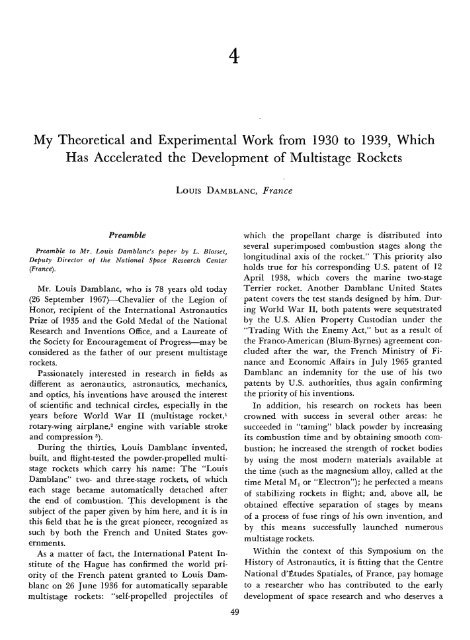FIRST STEPS TOWARD SPACE - Smithsonian Institution Libraries
FIRST STEPS TOWARD SPACE - Smithsonian Institution Libraries
FIRST STEPS TOWARD SPACE - Smithsonian Institution Libraries
You also want an ePaper? Increase the reach of your titles
YUMPU automatically turns print PDFs into web optimized ePapers that Google loves.
My Theoretical and Experimental Work from 1930 to 1939, Which<br />
Has Accelerated the Development of Multistage Rockets<br />
Preamble<br />
Preamble to Mr. Louis Damblanc's paper by L. Blosset,<br />
Deputy Director of the National Space Research Center<br />
(France).<br />
Mr. Louis Damblanc, who is 78 years old today<br />
(26 September 1967)—Chevalier of the Legion of<br />
Honor, recipient of the International Astronautics<br />
Prize of 1935 and the Gold Medal of the National<br />
Research and Inventions Office, and a Laureate of<br />
the Society for Encouragement of Progress—may be<br />
considered as the father of our present multistage<br />
rockets.<br />
Passionately interested in research in fields as<br />
different as aeronautics, astronautics, mechanics,<br />
and optics, his inventions have aroused the interest<br />
of scientific and technical circles, especially in the<br />
years before World War II (multistage rocket, 1<br />
rotary-wing airplane, 2 engine with variable stroke<br />
and compression 3 ).<br />
During the thirties, Louis Damblanc invented,<br />
built, and flight-tested the powder-propelled multistage<br />
rockets which carry his name: The "Louis<br />
Damblanc" two- and three-stage rockets, of which<br />
each stage became automatically detached after<br />
the end of combustion. This development is the<br />
subject of the paper given by him here, and it is in<br />
this field that he is the great pioneer, recognized as<br />
such by both the French and United States governments.<br />
As a matter of fact, the International Patent Institute<br />
of the Hague has confirmed the world priority<br />
of the French patent granted to Louis Damblanc<br />
on 26 June 1936 for automatically separable<br />
multistage rockets: "self-propelled projectiles of<br />
Louis DAMBLANC, France<br />
49<br />
which the propellant charge is distributed into<br />
several superimposed combustion stages along the<br />
longitudinal axis of the rocket." This priority also<br />
holds true for his corresponding U.S. patent of 12<br />
April 1938, which covers the marine two-stage<br />
Terrier rocket. Another Damblanc United States<br />
patent covers the test stands designed by him. During<br />
World War II, both patents were sequestrated<br />
by the U.S. Alien Property Custodian under the<br />
"Trading With the Enemy Act," but as a result of<br />
the Franco-American (Blum-Byrnes) agreement concluded<br />
after the war, the French Ministry of Finance<br />
and Economic Affairs in July 1965 granted<br />
Damblanc an indemnity for the use of his two<br />
patents by U.S. authorities, thus again confirming<br />
the priority of his inventions.<br />
In addition, his research on rockets has been<br />
crowned with success in several other areas: he<br />
succeeded in "taming" black powder by increasing<br />
its combustion time and by obtaining smooth combustion;<br />
he increased the strength of rocket bodies<br />
by using the most modern materials available at<br />
the time (such as the magnesium alloy, called at the<br />
time Metal M1 or "Electron"); he perfected a means<br />
of stabilizing rockets in flight; and, above all, he<br />
obtained effective separation of stages by means<br />
of a process of fuse rings of his own invention, and<br />
by this means successfully launched numerous<br />
multistage rockets.<br />
Within the context of this Symposium on the<br />
History of Astronautics, it is fitting that the Centre<br />
National d'ELudes Spatiales, of France, pay homage<br />
to a researcher who has contributed to the early<br />
development of space research and who deserves a

















